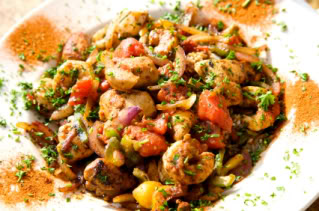I made this casserole dish for dinner for my family a few weeks ago and it was a big hit. I love how healthy this dish is. Most casseroles contain pasta or rice as the main ingredient along with some sort of meat while veggies are drenched in cream or some sort of rich sauce and added as an afterthought. Not this one. This dish is healthy and extremely delicious. My hubby claimed it to be the best casserole dish I've ever made!
Ingredients
1 medium head of cauliflower, about 2 pounds
1 tsp fine table salt
1 tbsp olive oil
1/2 pound of uncooked herbed chicken sausage OR spicy Italian sausage, removed from casings (I used chicken apple sausage, yum!)
1 medium onion, about 1/2 pound, diced
4 cloves of garlic, minced
2 stems fresh thyme, leaves only1 28-ounce can whole peeled tomatoes, drained and liquid reserved
1/4 cup grated Parmesan cheese
Kosher salt and freshly ground pepper to taste
Directions
Heat the oven to 350°F and lightly grease a 9x13-inch baking dish with olive oil.
Cut the cauliflower head in quarters. Slice away the leaves and stem, and with an angled cut cut away the core from each quarter of the cauliflower head. Chop cauliflower roughly into bite-sized florets, each about 1-inch across.
Bring 3 quarts of water to a boil over high heat. Stir in the salt. Add the cauliflower florets and boil for 2 minutes. Drain into a colander set in the sink. Run cold water over the florets to stop the cooking process and shake the colander to drain any excess water. Return the cauliflower to the cooking pot and set aside.
Place a 10-inch saute pan over medium-high heat. Add the olive oil and then, when the pan is quite hot, add the sausage. Use a spoon to break up the meat. Cook for 8 to 12 minutes, or until the sausage is cooked through and beginning to get crispy. If using chicken sausage there should not be a great deal of fat in the pan, but if using Italian sausage, drain all but 1 to 2 tablespoons of fat.
Turn the heat to medium-low and add the onion, garlic, and thyme to the pan with the sausage. Saute for 5 to 6 minutes, stirring frequently. Scrape up any brown bits as you saute. Crush the tomatoes, and add them to the sausage. Stir thoroughly, then add the reserved tomato sauce and cook for about 5 more minutes. Turn off the heat and taste the sauce. Add salt and pepper to taste.
Toss the sauce with the cauliflower in the cooking pot. Spread the cauliflower and sausage mix in the prepared baking dish and distribute evenly. Sprinkle the Parmesan cheese evenly over the cauliflower. Drizzle lightly with olive oil.
Place in the middle of the oven and bake for 25 minutes or until sauce is bubbling. Let stand for 5 minutes before serving.
Yields 4 - 6 servings.
What is your favorite gluten-free comfort food?



































